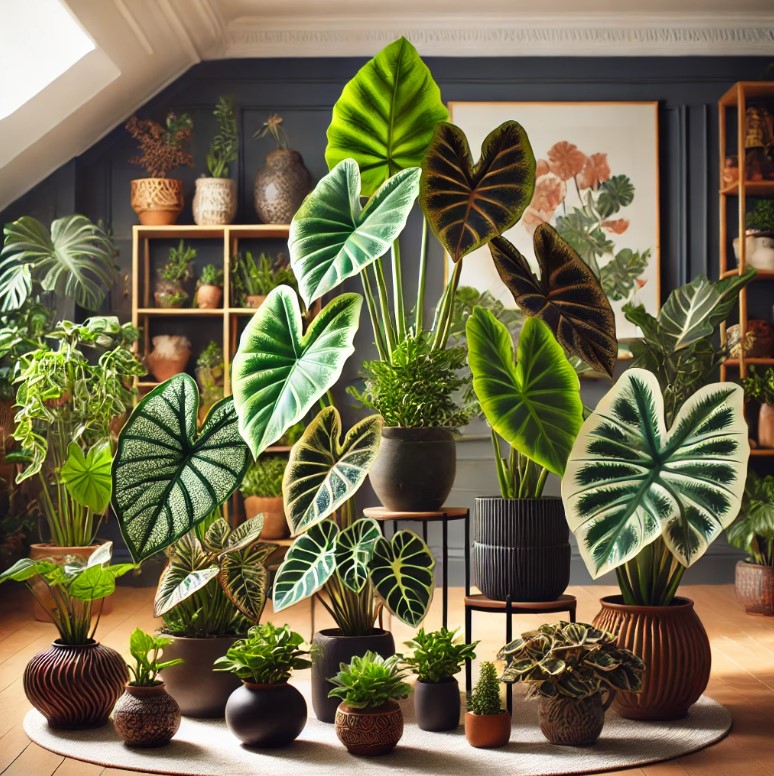
Alocasia is known for its distinctive appearance with lush and wide leaves, making it popular in indoor gardens. On the other hand, there are some particularities that, if you want to keep your Alocasia alive and flourishing, you will need to know. The care of Alocasia plant can be a little tricky for beginners, but if you pay attention to the three most important factors (watering, light and soil) these tropical beauties can thrive indoors. In this guide, we will review some critical aspects of maintaining healthy Alocasia plants to help them flourish in your home.
Reasons to Select Alocasia for Garden Indoors.
Alocasia plants are dramatic leafy beauties that inspire exotic fantasies and lift any interior. Fascinating shapes and flamboyant colours of their leaves make them attention-seeking houseplants. However, and this is a big however, there are some things we need to know how to take care of an indoor cactus before getting one home.
1. Must-Know Care Tips For Growing An Alocasia Plant
Here, we go over everything from how much to water them to light requirements so that you can provide an optimal growing environment for your Alocasia houseplants.
2. Alocasia Light, Subheading 1: Happenings – What the Alocasia Needs
Alocasia loves to be in bright, indirect light. Full sun can burn their foliage so be sure to put them where they will receive abundant filtered sunlight. They can also tolerate less light but will likely grow slower. Leaves are a good way to check if the plant is receiving ample amounts of light or not.
3. All right, let us move on further to how you should water your Alocasia.
Proper watering is one of the most important things to get right when it comes to caring for Alocasia. These plants like their soil to be consistently moist while being careful to not let them sit in water. Water well when the top inch of soil is dry to the touch but drain excess from beneath pot so roots don’t rot.
4. Ideal Soil for Alocasia — Subheading 3
Well draining soil whilst keeping moisture, this is the type of soil it will be better in for alocasia plants. The ideal medium for your plant is a well-balanced combination of peat, perlite and orchid bark. This helps it to drain well and still leave enough moisture for the roots of the plant.
5. Temperature and Humidity Preferences
Alocasia plants hail from warm, humid climates of tropics. The ideal temperature is somewhere between 65-80°F (18°C to 27°C), and it should be humid; ideally, you want the humidity levels in there to be anywhere from about 60-80%. To boost humidity, put your Alocasia on a humidity tray or you can also use a humidifier.
6. How to Fertilize Alocasia for Best results
In the growing season (spring and summer), fertilizing your Alocasia aids its performance. Fertilizer — A balanced, water-soluble fertilizer monthly The plant naturally slows down in growth during winter too, so do not fertilize it.
7. Repotting Alocasia – Detailed Explanation: A Little More in Depth
Alocasia normally requires repotting every 1 to 2 years. Its time for a new plant home — if many roots are poking through the bottom of the pot or if soil has turned hard. Tip: When re-potting, ensure the next pot is only a little larger than the current one— this prevents waterlogging.
8.Alocasia Pests and How to Combat Them
Protecting Alocasia Plants From Pests Spider mites, aphids and mealybugs are a few of the pests that can bother your Alocasia. Look out for spider mites, which are found on the undersides of leaves and cause discoloration; treat them with insecticidal soap or by wiping underneath the affected leaves with a damp cloth as needed.
Alocasia propagation is very possible either through division but check the above list to see if your alocasia will tolerate it.
Alocasia can be propagated by division. When repotting ensure that when you are removing cuttings to gently separate the offsets with some roots, if possible. Root the divisions in new soil and keep warm and moist until they begin to grow again.
9: How To Know If You Over Watered Or Underwater Your Plants
By knowing how to tell when an Alocasia has been overwatered or underwatered, you will be able to keep your plant healthy. Overwatering leads to yellowing leaves, along with root rot; while droopier leaves and dry soil indicates underwatering.
10. Alocasia Leaf Care – How To Prune Alocasia Leaves
Frequently eliminate any dead or yellowing leaves to keep the plant looking neat and stimulate new growth. Use scissors which are sharp and clean so as not to hurt the plant.
11. Alocasia is a poisonous plant
Ingestion of Alocasia plants is toxic to both pets and humans. For households with small children or animals, placement should be considered carefully. Make sure the plant is always out of reach, and in case you ingest one call a doctor or veterinarian straight away.
12: Popular Alocasia Types for House Planting
Some of the most popular indoor varieties are Alocasia Polly, Alocasia Frydek, and Alocasia Amazonica. They each have their own characteristics and care requirements, so familiarize yourself with the details of whatever variety you decide to grow.
13: Alocasia Life Cycle: Winter Dormancy
From spring to summer, Alocasia is most active as this is its growing season. They tend to slow or stop growing in fall and winter, often going dormant. Cut down on watering, and DO NOT fertilize during these months to allow your plant to rest properly.
14: The beauteous, but hard plant That kicks its recommendation issues
If you notice browning tips, curling leaves, or stunted growth on your Alocasia — you’re probably caring for it all wrong. These issues are usually caused by low humidity, not enough light or too much water. Revise care routines as needed to accommodate these concerns.
How to Purchase Alocasia Plants.
You can buy healthy Alocasia varieties from online and local plant stores, if you want to introduce one of them in your home. You can buy from some trusted ones like well-known plant nurseries or get them online on Etsy or Amazon. Select a seller with good reviews for the best quality plants.
Conclusion
If you care for them properly, Alocasia plants can live happily inside as a great touch of tropical beauty. This guide walks you through everything from ideal watering and soil requirements to humidity and pest control, so that your Alocasia can thrive in your home. With these tips in mind, you can have the lush, dramatic leaves of these gorgeous plants year-round.






